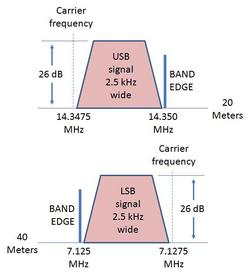First, the lower edge of the US phone band is 7.125 MHz - not 7.100 MHz. The requirement is for you to keep your signal above 7.125 - all of it. If you are using LSB, the frequency display of your radio shows the carrier frequency and that has to be high enough that the sidebands of your signal are all inside the phone band. What does that mean? According to the FCC in Part 97.3a, everything stronger than 26 dB below the mean power of the signal counts as the signal's bandwidth.
 Make sure your signal is clean and that the rig's displayed frequency of your carrier is far enough from the edge of the band to stay legal! Make sure your signal is clean and that the rig's displayed frequency of your carrier is far enough from the edge of the band to stay legal! |
A similar problem over the past couple of years has been stations at the top end of 20 meters with their USB carrier frequency above 14.3475 - you're out of the band, folks! Again, just don't call them - these are not the usual frequencies for rare stations.
Another "gotcha" is caused by jumping to that freshly posted spot and giving your call without looking closely at the frequency. DX stations can operate well below 7.125 MHz, 14.150 MHz, and 21.200 MHz - don't call them there! In every contest, you can hear a steady stream of US stations well outside the US band who should know better. If you can program your radios not to transmit outside the US segments or set up your spotting network filters or logging program not to tempt you with out-of-band spots, do so. That way, in the heat of battle, you won't make a mistake. Or be tempted to "make a mistake."
Finally, before sending in your log - make sure it states the right category for your entry. If you receive ANY spots from the spotting networks by any means, you must enter in the Single-Operator, Assisted category (SOA). Most logging programs now automatically connect to the Internet and then to a spotting network, so you have to disable that feature if you are going to enter Single-Operator.
As you get ready for radiosport's Big One, remember to play nice. Have fun, definitely, but be sure to set good examples for good operating and clean signals. The world does listen - especially when you're living on the edge!
73, Ward NØAX
No comments:
Post a Comment